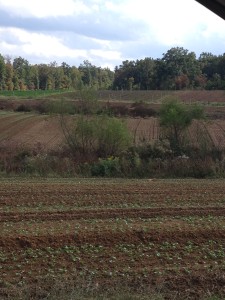by Kristen Gurley (JD ’15) and Amanda Phillips (JD ’15)
Grundy County, Tennessee, has nearly 14,000 residents, 360 square miles of land, seven public schools . . . and only two grocery stores. On our recent trip to the county for the Harvard Food Law and Policy Clinic, we asked how the former could possibly be sustained by the latter.
We arrived in Chattanooga on Wednesday, October 8. The hour-long drive to Grundy County was as scenic as it was relaxing. Far from the traffic and congestion of Cambridge, the Tennessee countryside consisted of winding highways, sun-splashed rivers and lakes, and breathtaking views of mountains and valleys. Grundy County itself was no different. Encompassing rolling mountains and a large plateau, Grundy County boasted several state parks, long hiking trails, and miles of wooded countryside interspersed with well-maintained farmland.
As beautiful as the scenery was, though, there was a lot to miss about Cambridge. The 14,000 residents were spread out around the county—not only in five smaller townships, but interspersed in between. Many houses were miles away from any commercial retail, and the food retail available often consisted of Dollar Generals or CVSs. To get to one of the two grocery stores in the county, many residents would have to make a twenty to forty minute drive. Access to healthy food was in short supply.
With the large amount of farmland, the lack of healthy food retail seemed like a contradiction. We found out that the county had certain “higher end” venues (“The Mountain Goat”) for specialty items, pop-up stands by individual farmers, and a farmers market that opened a few days a week. However, it appeared that much of the healthy food being grown was shipped out of the county and away from county residents.
Our focus for this trip was to redirect some of these food shipments to Grundy’s school children. On Thursday, October 9, we held a meeting at a century-old bakery to discuss the issue. The meeting involved members of the Grundy County Appalachian Diabetes Coalition (which is one of many coalitions that receive grants to implement programs combating diabetes), the Grundy County School Nutrition Director (who was in charge of procuring food for school meals), and leaders of the Grundy County Food Hub (which aggregates food from farmers in the region to meet the supply of large institutions—currently the University of the South). We hoped to help the Appalachian Diabetes Coalition serve as a “matchmaker” between the supply of the food hub and the demand of local schools.
Although we were armed to the hilt with persuasive information on the value of getting fresh and local fruits and vegetables into school cafeterias, we found we were speaking to the choir. The Grundy County natives were well aware of their food situation—particularly the needs of local farmers to have a source of local demand. We facilitated a discussion about potential options for opening up school channels, and we were pleased to hear that they were as excited about farm to school as we were—both to help Grundy county youth and to support Grundy county farmers.
We will spend the rest of the semester working with our new friends in Grundy County to provide technical assistance to help overcome logistical and economical roadblocks and turn the initial conversation into an action plan. Although the journey may be walked in baby steps rather than giant leaps, Grundy County is lucky enough to have advocates who truly care about the health of its citizens, and for that reason, we know Grundy County will meet the challenge.

Amanda Phillips (FLPC), Shelia Plogger (Marshall University), Kristie Gurley (FLPC), Tonya Gardner (Grundy County), and Alli Condra (FLPC)
————–
The views reflected in this blog are those of the individual authors and do not necessarily represent those of the Center for Health Law & Policy Innovation or Harvard Law School. This blog is solely informational in nature, and not intended as a substitute for competent legal advice from a licensed and retained attorney in your state or country.





Health Law & Policy, Commentary
Braidwood Management v. Becerra: Updated FAQs for Health Advocates and Providers
July 22, 2024